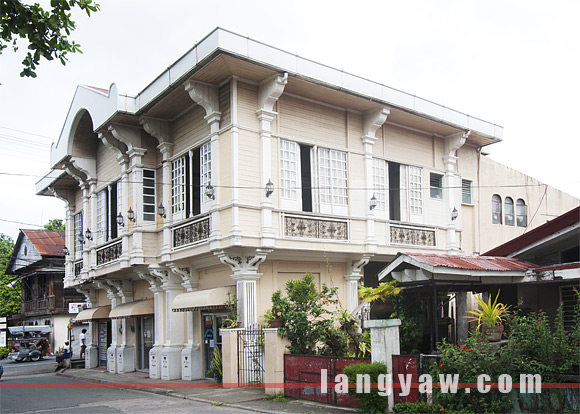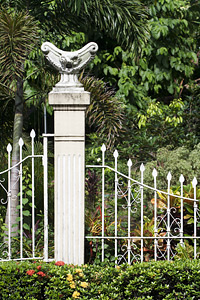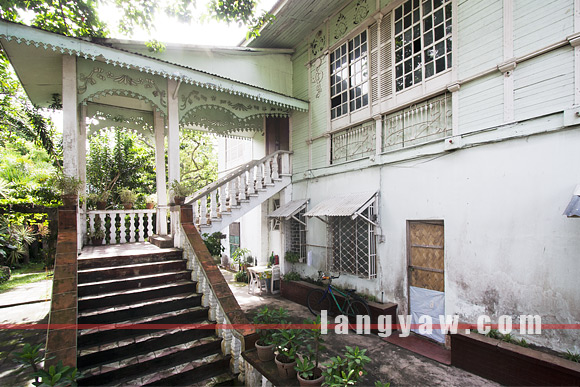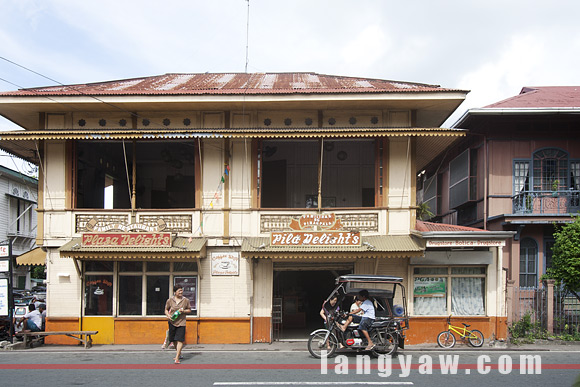
I went down at the bus stop in the poblacion of Pila in Laguna on a sunny and balmy Sunday morning, 80 kilometers from Manila.  The bus’s airconditioning and muted exterior sounds due to its enclosed state gave way to the warm outside temperature and the cacophony of retro styled tricycles going about their business while  the townsfolk was just getting ready for the mass.
Declared as a National Historical Landmark by the National Historical Institute in 2000, a quick scan of the town center already reveals an astonishing number of early 20th century domestic architecture and other structures that give its provincial atmosphere a unique flavour.

History
Pila, referring to the loose soil, is steeped in history with a flourishing pre-hispanic community and commercial tradition being a rich trading outpost along the Lawa ng Baé, which the Spaniards later called Laguna de Bay. The Laguna Copperplate Inscription, written in Kavi script was discovered in Lumban (Laguna) in 1989 and dated 900 A.D. mentions of a gold debt transaction that mentioned old place names that included Pailah (Pila).

A 1967 archaeological expedition at its original site in Pinagbayanan uncovered a rich trove of locally manufactured pottery and several Chinese porcelains from the Northern Sung (960-1127 AD), Southern Sung (1127-1280 AD) to the Yuan dynasties (1280-1368 A.D.). Such is the renown of the town but around 1375, it has to move to its second site called Pagalangan due to a calamity when the lawa started to flood.
The Spanish conquistadors led by Don Juan de Salcedo arrived in 1571 and made Pila as an encomienda with tributes to be collected. Around 1610, it was raised to the status of a villa, an honorary title which is the Spanish equivalent to the English borough because of the hospitality of its people, culture, population and extensive territory, as well as its importance in the southern gold route (the gold mines of Paracale in Bicol – Manila).
For the town, La Noble Villa de Pila enjoyed certain privileges like exemptions for the nobility from paying tributes, performing forced labor and personal services. The villa title was also enjoyed by seven other areas in Luzon and the Visayas during the time of Spanish colonial rule.


The Franciscans established the second printing press in the country in Pila where Pedro de San Buenaventura, OFM, published in 1613 his Vocabulario de Lengua Tagala based on his observations of the language in the town which is considered to have one of the purest forms. This is older by 25 years the first book published in the United States.
In the first decade of the 19th century, the town, again affected by the cyclical flooding of the Laguna de Bay, finally relocated to Pila’s present site.
At the closing of the 19th century, the town was almost decimated except for the church and the convent during the Spanish-American War. In World War II, Pila was spared from destruction that the townspeople attributed to the intercession and protection of their patron saint, St. Anthony of Padua. They later adopted the honorific title of Bayang Pinagpala, the blessed town.

The town’s layout and architecture

Don Felizardo de Rivera founded Nueva Pila, the town at the new location, formerly Barangay Sta. Clara. He designed the gridiron layout following the traditional Spanish town-plaza complex where the church and convent are located on one side of the spacious plaza, the Municipal Hall and school at the other and the rest, the homes of the principalia, or the prominent families of the town.
This setup led to the terms taga gitna, from the center, and taga labas, referring to the indios, natives, who were residing at the periphery. The main street, Calle Rivera cuts the town and connects it to the old settlement of Pagalangan, now in the municipality of Victoria.

The town center is dominated by the 200 year old parish church with its three storey facade crowned by a triangular pediment, all made from volcanic tuft locally known as adobe. The octagonal belfry of two levels is made from red bricks, sits atop a quadrilateral base providing a stark color contrast to the otherwise drab facade.
The former convent, now the Liceo de Pila, with its beautiful front arcade provides a pleasing counterpoint to the heavy and squat, earthquake baroque structure of the church. Â It was declared as the Diocesan Shrine to St. Anthony of Padua on 9 July 2002.
Pila was a rich and prosperous town due to its fertile soil and the principalia’s houses were made of the grand bahay-na-bato structures, the Filipino noble house, typical of the period. A bahay-na-bato, literally, stone house, is a Filipino evolution of the humble bahay kubo, the traditional house made of light materials typically with the living quarters raised from the ground to protect the inhabitants from wild animals while the lower part became storage area or was fenced as animal coop.
When stone was introduced by the Spaniards as a building material, it became the rage in many cities and major towns but because of the many earthquakes that happened, building style has to give way to practicality. The bahay-na-bato was transformed: the upper levels made of wood and supported solely with harigues, hardwood posts from the forest, and the lower part wrapped with stone like a skirt. It has the same spatial arrangements as the bahay kubo.

The Americans torched Pila during the Spanish-American War leaving only the church, convent and the escuela pia intact. Faced with a bleak future, the townsfolk cleared the ruins and built modest houses in place of the grand bahay-na-bato. However, starting from the first decade of the 19th century until 1930, just before the effect of the Great Depression came into full swing, the town enjoyed a second economic boom and the building rage commenced. The modest structures were torn down and replaced with the present ones seen today.

There are a total of 35 historic structures in Pila of which 30 are ancestral houses and two public buildings: the municipal hall and the elementary school, built in the span of three decades during the start of the 20th century except those from the Spanish colonial era.
Most of the structures are of the Commonwealth American period and it is interesting to note that the Antillan style, the Filipino version of the Spanish colonial architecture that developed in the islands is still very much apparent.

Wide capiz shell windows open to airy and meticulously decorated interiors with intricate carvings and colourful painted ceilings. Beautiful wrought iron grills with different designs, depending on the house, cover ventanillas. Balustraded grand staircases made of cement are typically found at the side of the house leading to the caida. Most still retain the bahay-na-bato template with the lower portion made from cement and retaining the wooden upper levels.
Pila is one of those few towns in the country that not only has successfully kept intact its period feel but still exudes its old world charm because of all these structures and provincial atmosphere. Even sitting on one of its benches under the shade of those trees can be a palliative from the hustle and bustle of Metro Manila, a quite escape.
Article originally published in Space Magazine August-October 2011 issue.
It offers a lot of history! Pila, Laguna.. Pipilahan ko yan sa mga towns na ivivisit in the future, lol!
Ang ganda sir. Bihira nalang yung mga towns na may at least 5 well-preserved old houses standing in a row. Minsan sa gitna nila may nakapagitnang bagong building 🙁
Nice find!
awesome architectures! i’d visit this soon… thanks for sharing Estan! 🙂
ed, pila is one of the very few well preserved town centers in the country 🙂
welcome! madaming bahay pa yan!
Been here a few days ago. I love old houses 🙂
i agree paula. looking at these houses just transports one back in time
This is really really amazing! 🙂
Don Mervino…mahihilo ka dito pag nakita mo :-)..
Thank you for your article.
The declaration of Pila as a National Historical Landmark was in the year 2000 (May 17) and not 2007.
The were no bahay na bato built when the town was moved from Pagalangan (now Victoria) to the present site. I am not sure if the Americans burned the houses. My grandmother who would be 120 years old never mentioned such an incident when she told us stories about Pila.
Cora, thanx for the correction.
Cora, regarding the burning of the houses, I based it from published article but couldn’t remember now the title. I pressume that since the town transferred in the early 19th century, bahay-na-bato should have been built. In this article, I mentioned that the current houses were built in the early 20th century.